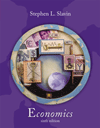|
 |  Economics, 6/e Stephen L. Slavin
What's New and Improved- Pedagogy improved!
- Questions answered: The author has revised and increased the number of "Questions for Further Thought and Discussion at the end of each chapter. He has provided answers to these questions, which can now be found in the improved Instructor's Manual.
- Graphs explained: Explanatory captions have been added to more than two-thirds of the graphs in the text.
- New International Icon: An International Icon alerts the reader throughout the text to global perspectives found in the discussion at hand.
- Supplement package heavily revised by two long-time users
- The Test Bank (co-author Jim Watson, Jefferson College) contains over 8,500 test questions, including 2,500 new and revised questions - 22% more questions than in 5e.
- The Instructor's Manual (co-author Mark Maier, Glendale Community College) contains new sections with print and web resources, teaching ideas for lectures and collaborative learning group exercises.
- New Chapter on the Export-Import Factor (8). New chapter 8 will introduce the basis for international trade, US imports and exports, a summing up of C+I+G+Xn, the world's trading nations, world trade agreements and free-trade zones. Many reviewers wanted to see more non-technical international material near the beginning of the text. With this new organization, students get a better foothold on the fundamentals before moving on to the more complex coverage in Chapters 32 and 33.
- Chapter 16, "Economic Growth and Productivity," Greatly Revised. The major theme of this chapter has changed. From the mid-1970's to the mid-1990's, productivity growth had slowed, and in previous editions, this chapter discussed why that was happening. Now that productivity growth has picked up again, the chapter discusses the upsurge and is more optimistic in its outlook. This change keeps the coverage very current.
- Chapters Reorganized and Streamlined.
- Chapters 3 and 17 are now combined into a single supply and demand chapter and placed where Chapter 3 is now. Chapter 3 contains sections on reading supply and demand curves. The new Chapter 17 concentrates on drawing supply and demand curves.
- New Chapter 17 is a combination of Chapters 17, 18, and 20 from the previous edition and is titled Demand, Supply and Equilibrium.
- Chapters 18 (The Elasticities of Demand and Supply), Chapter 20 (Cost), and Chapter 21 (Profit Maximization) are new chapters based on material from Chapters 18, 20, 21, and 22 of the fifth edition.
- Great Value. The text's low price continues to make it one of the best values on the market. It's approximately $25 less than other principles texts.
- The built-in study guide has perforated pages that students can tear out and hand in to the instructor. Students don't need to purchase an additional expensive text supplement; they can write right into the exercises at the end of each chapter.
- The author's humorous writing style and historical approach to economics is a hit with students, who might otherwise find the subject too dry or intimidating. Steve Slavin is an experienced and respected author-- in addition to having over 30 years experience teaching the principles course, he has written 11 other math and economics books.
- Dozens of self-help boxes anticipate and answer frequently asked questions.
- Math Reviews. The book reviews math that students should have learned in middle school. The better prepared students can skip this material, but this review enables all students to start on a level playing field in the course.
- Many advanced work boxes provide more challenging work, giving adventurous students an opportunity to learn and master difficult material. This optional material can be easily skipped over by instructors.
|
|
|



 2002 McGraw-Hill Higher Education
2002 McGraw-Hill Higher Education

 2002 McGraw-Hill Higher Education
2002 McGraw-Hill Higher Education